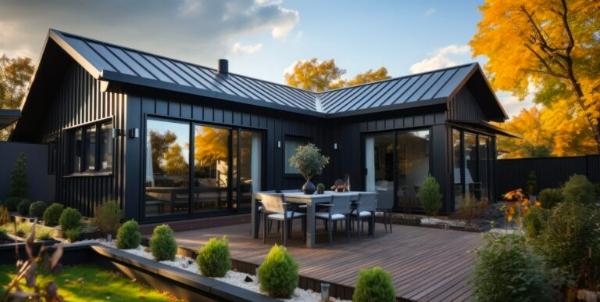UP TO THE MINUTE
The pros and cons of popular roofing materials

By Alli Gordon, SmartBuild Systems.
Performance, aesthetics and climate all play a role in which roofing material is going to be right for your project
Your choice of roofing material has a significant impact on your home’s protection, visual attraction, and the property’s curb appeal.
The material you choose for your roof is a critical decision for both the construction project managers and roofing professionals. There is a diverse selection of roofing materials, and it is essential to know what scenario each material is suited for. This list is an informative guide outlining valuable insights and specific factors to consider while searching for a new roof.
Metal roofs
Metal roofs continue to be one of the most popular options for both residential and industrial buildings due to their durability and longevity.
Metal roofs are most commonly available as metal shingles or as a standing seam construction. Metal shingles are often considered to be more aesthetically pleasing, but both are highly resistant to fire and high winds.
Ideal for areas that see heavy snow and ice, metal roofs may not be the best option for rainy climates due to the noise factor.
Shingles
Shingles are one of the most popular roofing materials available and come in several varieties, including asphalt composite and slate.
Asphalt composite shingles are the go-to for residential builds. Durable and lightweight, they are one of the easier roofing materials to install and replace and are ideal for large construction projects such as housing developments.
However, asphalt composite shingles are somewhat vulnerable to weather and may not be the best option for areas with frequent strong winds.
Another option when it comes to shingles is slate. Most commonly seen on high-end, luxury homes, slate shingles are one of the longest-lasting roofing materials out there. They come with the added bonus of being low maintenance and virtually impenetrable to moisture.
On the downside, slate is considerably more expensive regarding material cost and labor, as specialized qualified installers are required. Due to their weight, slate shingles are also only suitable for homes or buildings with a high roof weight capacity.
Clay tile
Perfect for enduring high temperatures and resisting the corrosiveness of salty air, clay tiles are extremely popular in coastal areas.
They are also extremely durable, able to withstand extreme weather conditions such as hurricanes, and have the added advantages of being eco-friendly and energy efficient.
However, clay tiles can be cost-prohibitive and, like slate, require specialized installers to perform the labor.
A few other options
There are many roofing options for larger construction projects, but two notable ones are rolled roofing and built-up roofing.
Rolled roofing is a cheap, fast, and convenient material for buildings such as workshops, sheds, and garages. However, it has no aesthetic appeal and only lasts for a few years before it needs to be replaced. Rolled roofing is likely best for temporary constructions or smaller buildings that don’t require much labor when it comes time to replace the roof.
In contrast, built-up roofing, or BUR, involves stacking layers of asphalt between ply sheets over a roof deck. Durable and practically impervious to the elements, BUR is the ideal option for flat and low-pitch roofs and is commonly seen on the tops of low-rise buildings.
RoofingPassport from SmartBuild Systems can help you find the right roofing material
Whatever your roofing project, it’s important to select the material that will meet the needs of your client.
With RoofingPassport from SmartBuildSystems, you can create complete roofing bids in just 5 minutes without ever having to leave your office and bid with any material.
The ideal software solution for both residential and commercial builders, RoofingPassport provides highly accurate roof measurements and gives contractors complete control over the entire roofing process.
Get in touch with SmartBuild Systems today to learn how RoofingPassport can help elevate your roofing business and streamline your bidding process.
Learn more about SmartBuild Systems in their Coffee Shop Directory or visit www.SmartBuildSystems.com.



















Comments
Leave a Reply
Have an account? Login to leave a comment!
Sign In